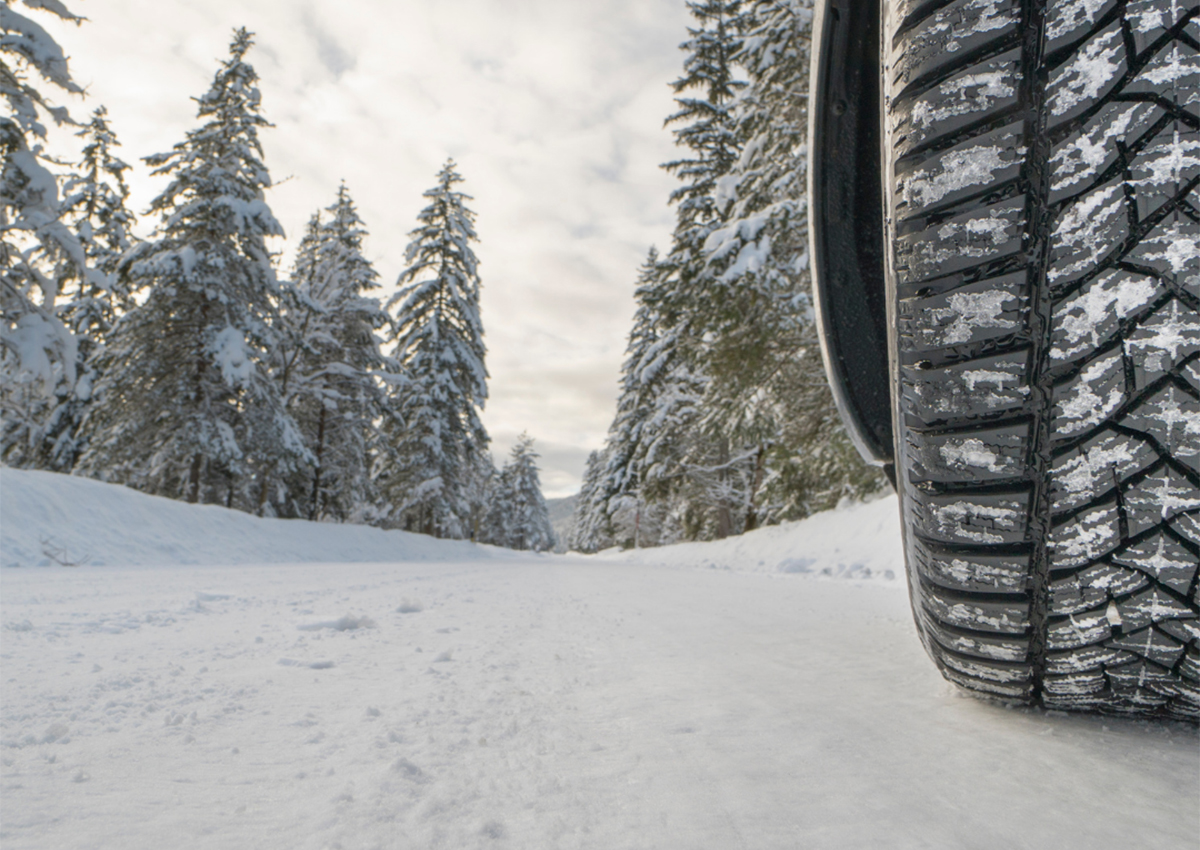Driving in the winter may be a challenging experience, and safety is dependent on the driver’s ability to navigate winter dangers, as well as proper vehicle maintenance and, of course, a good set of winter tires. Due to their large tread gap design and high natural rubber content, winter tires are designed for driving in snow and ice, increasing traction and improving grip and handling. They’ve also passed a winter traction performance test, earning them the right to display the 3PMSF-Three Peak Mountain Snowflake emblem on their sidewalls, indicating that they’re ready to tackle snowy, icy roads.
What makes winter tires perfect for winter driving?
Extreme winter circumstances, such as hiking through snow or driving on ice, are not suitable for an all-season tire. Winter tires, which are specially built to function in winter situations, are ideally suited to the combination of freezing temperatures, ice, and snow. So, why are they ideal for extreme winter conditions?
- They have a unique tread design
They have a higher “void-to-lug” ratio, which means the grooves between the tread blocks are larger. In addition, the tread blocks feature uneven, sharp edges to help push snow into gaps, allowing it to reach down and make contact with the road surface. Additionally, the treads are designed to evacuate the snow and slush out the back of the tire as it rotates.
- The incredible Sipes
The numerous, fine, deep incisions known as sipes in winter tire treads work like claws, ensuring maximum performance in both dry and ice terrain. They contain ten times the number of sipes as summer tires, giving them additional flexibility on dry surfaces.
- The soft rubber compound
Snow tires are distinguished from contemporary tires by their rubber compound and tire construction, specifically how the compound is combined with the steel weave. These tires’ rubber composition is designed to be soft and supple even at cold temperatures (below 70 C), enhancing their grip on slick terrain.
Winter tires are most effective when packed with snow, and the ultimate grip is determined by how well the rubber can sink into the surface. Unlike all-season and summer tires, which become stiff and brittle as temperatures drop below 70C, winter tires remain soft and prevent slipping.
- Better stopping
Millions of small pores are revealed as the tire wears down, and they operate as a larger version of the sipes. These little bubbles help to remove water from the ice beneath the tire, reducing slippage. Snow tires can decrease your stopping distance by up to 37% making them a safe bet in winter.
- Optimized traction on snow and ice
The rubber compound in winter tires is fitted with a hydrophilic coating. Not much of a whiz when it comes to engineering? The term ‘hydrophilic’ simply means ‘water-loving’. Regular rubber repels water and generates a slick surface, whereas hydrophilic rubber functions like a microscopic sponge, providing winter tires additional traction on ice.
A quick guide to selecting the right snow tires for your car.
Whether you are a first-timer or a regular winter tires user, selecting the best tires for your car can be a doting task but these three steps can guide you through the process;
- Three-Peak Mountain Snowflake symbol
The three-peak mountain snowflake emblem is a certification that ensures winter tires meet the US and Canadian tire regulations. The snow performance of these winter tires has been verified to meet or exceed established limitations in objective tests. On snow, ice roads, and in general at cold temperatures, these tires perform well in terms of safety and control.
- Check the tread depth
The easiest technique to determine tread depth is to consult a tire professional at roundtires. Alternatively, you can place the Canadian quarter’s caribou nose-first in the tread’s deepest point. You’re safe if the tip of the nose disappears; if it remains visible, the tread depth is insufficient.
- Select Performance Features Based On Your Driving Needs
Consider performance features such as better fuel economy, faster braking, smoother handling, greater comfort, and so on. See why we recommend The Michelin winter tire below.
Factors to consider when switching to winter tires
A general rule of thumb is to switch to winter tires when the ambient temperature drops below 45o Fahrenheit or when you can consistently see your breath. The decision to install winter tires is influenced by;
- The frequency of cold temperatures in your area:
Winter tires are strongly advised if the daily average temperature falls below -7°C. However, if you’re lucky enough to have mild winters, all-seasons may suffice.
- Road conditions in your area:
Winter tires are highly recommended if you frequently drive on icy roads and hard-packed snow. They are required on most routes in British Columbia from October 1 to March 31. The date is extended to April 30 for selected highways, mountain passes and rural routes where early spring snowfall is experienced. Quebec residents are required to install them on their vehicles by December 1st of each year and to keep them on until March 15th of the following spring. Other provinces do not require the switch, but tire experts strongly advise it.
- How much winters driving you’ll be doing:
Winter tires are recommended for persons who work in professions that demand them to be mobile, such as doctors and nurses. You might keep your all-weather tires if you work from home or an occasional driver.
- Time of day when you are driving:
In contrast to driving during the day, driving in the early mornings or late at night requires the use of winter tires. However, this should not be the most important consideration.
- The costs you are willing to undertake:
Winter tires require you to pay for seasonal tire changes unlike all-weather tires that are a year-round tire but wear faster.
Why do I need four snow tires mounted on their own wheels?
Installing all four winter tires, regardless of whether your vehicle is front or rear wheel drive, is recommended to improve vehicle control and stability. Anything less than four tires jeopardizes vehicle safety and tire efficacy overall.
Installing them on the front axle improves front-end grip and gives the driver a false sense of security. The difference in tire grip between the front and rear wheels will cause oversteering. Installing them just on the rear axle, on the other hand, will increase rear-end grip, resulting in understeer due to the difference in grip between the front and back tires.
Mounting winter tires on their own set of wheels reduces tire wear and tear, saves money, and saves on time spent at the auto shop. Steel wheels are preferred over alloy rims because the material on them is significantly more stable and thus less susceptible to de-icing salt and grit.
What do tire experts say about tire pressure in cold weather?
For passenger cars, the recommended tire pressure is 30-35 PSI (pounds of force per square inch) all year round. The appropriate pressure for your car can be found inside the driver’s door, on the fuel filler door, or in the specific vehicle manual.
Lower temperatures mean lower tire pressure. Tires lose one to two psi for every 100 F dip in outdoor temperature, according to tire manufacturers. This means that if the temperature lowers by 200 F on weekends, your automobile might lose up to 4 psi. As a result, you may need to pump your tires throughout the winter. Always;
- Check your tires at least every two weeks
This will ensure that you keep your tires’ psi at the recommended level. Signs of an underinflated tire include; a warning light triggered by your Tire Pressure Monitoring System (TPMS), tire looks flatter than usual, the steering wheel shakes or vehicle takes longer to come to a stop when braking.
- Check tire pressure only when the car has been parked for at least one hour or early in the morning.
A rise in air temperature caused by driving will also raise the air pressure in the tires.
Why we recommend Michelin X-Ice Snow tire for winter driving
- 3D sipes Design
The new Michelin X-Ice Snow tire’s sipes have a 3D feature design and extend two millimeters below the wear bars to keep the tire performing even as its useful life approaches. These sipes also interlock to maintain rigidity, which results in better steering feel under sheer lock.
- X-ceptional deep snow traction
The Flex-Ice 2.0 employs inclusion technology, which creates micro-roughness on the tread surface, aiding in grip in both snow and ice, winter after winter.
- The rubber compound technology
The compound contains a high silica content that ensures the tire maintains its flexibility, even in severe climates. This advanced compound is molded into a continuous V-Shape, directional tread pattern with increased groove widths engineered to improve hydroplaning and slush performance, as well as increase the snow-to-snow traction needed for loose conditions.
Wrapping up
Though there are other alternatives like all-season tires, winter tires are something you definitely need in the winter season. No other tires can give you better handling in winter on ice-covered roads than winter tires.


